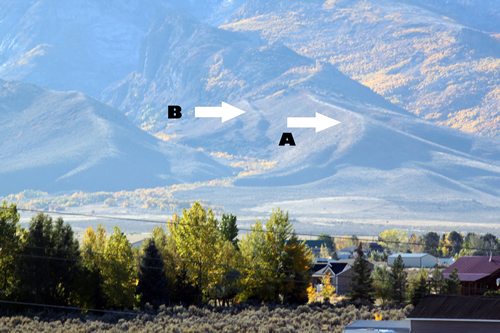
Seitz Canyon shows heavy glacial sculpting
Showcasing the Glacial sculpting of the Ruby Mountains
By Larry Hyslop

Seitz Canyon shows heavy glacial sculpting
Last Saturday, on a drive toward Lamoille Canyon, the morning sun was just right to clearly highlight the glacial sculpturing that carved the magnificent peaks and canyons of the Ruby Mountains. I had to turn off the highway at Pike’s Road just to marvel at this view.
Ruby Dome’s glacially carved face was easy to make out. Below and slightly to the left, I could see Seitz Canyon with a bottom full of fall-yellow aspens. This rugged canyon’s U-shape shows it was heavily glaciated during past ice ages
The Rubies show clear evidence of the last two glacial advances. Earlier advances occurred but any evidence was likely destroyed by these last two. The earlier advance took place about 150,000 years ago. At that time, a glacier perhaps 1,000 feet thick scraped its way down Lamoille Canyon and out the canyon’s mouth onto the open slopes. A similar glacier advanced down Seitz Canyon and finally stopped outside its canyon mouth.
Glaciers are not merely made of ice, however, since the ice contains numerous boulders, along with sand and gravel. Any ice exposed to air melts and a glacier’s front face builds up a pile of rock debris called a terminal moraine. Lamoille Canyon’s road climbs over this terminal moraine before entering the canyon. The glacier’s sides, where ice meets canyon wall, also melt. Rock debris piles up on the canyon wall, creating a deposit called a lateral moraine. Over thousands of years, glaciers slowly advance down canyons, leaving behind canyon walls carrying a smooth coating of rock debris. Angel Lake’s canyon walls clearly show this smooth lateral moraine.
In the above photo, the letter A points to Seitz Canyon’s west wall with such a lateral moraine. This lateral moraine developed during the first glacial advance when the glacier emerged from the canyon mouth, leaving the entire canyon wall with a smooth surface.
The more recent glacial advance took place only 15,000 years ago and was not as extensive. Glaciers did not advance as far down canyons. In the case of Angel Lake, the more recent advance stopped at today’s lake edge. Angel Canyon’s terminal moraine created the dam that created the lake. This more recent advance in Lamoille Canyon stopped near today’s Lions Camp.
Seitz Canyon also shows evidence of this more recent glacial advance. The letter B points to a second lateral moraine that built up on the surface of the first moraine. This more recent glacier did not advance as far and this second lateral moraine stops short of the canyon mouth.
One of my favorite themes is the unique qualities of the Ruby Mountains. No other nearby mountain range was as heavily glaciated. During your next drive to Lamoille Canyon, pull off the highway and look for the evidence of glaciation that carved these magnificent mountains.
Elko Daily Free Press, “Nature Notes”, 10/27/2011
© Gray Jay Press, Elko, NV
Return to Elko Nature Notes